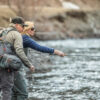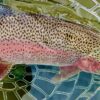
“The poetry of the sport hooked me long before I learned the prose.” – Judy Muller
There are those who fish with precision, making each cast direct and to the point. And there are those who fish with the fly in the air as much as it is on the water, making each presentation as if it is a prayer. Some anglers scan the water searching the surface for movement, a rise, a dimple, a flash of color. And others who look deep for structure and imagine the possibilities. Just as there are many different ways to catch a fish, there are varied ways to read a river. Whether you are hooked by the poetry or are just learning the prose, remember, the river is where the stories begin. This fall, make every excursion your masterpiece.
SILVER CREEK
If you head to the Nature Conservancy or Kilpatrick’s Pond, expect to find the usual array of fall bugs. Of course, the timing of the hatch all depends on the air temperature, so pay close attention to the weather report. On a typical day, we are still seeing some Tricos mixed with Baetis by late morning. Afternoons are a mix of Baetis and Callibaetis along with the occasional Mahogany Dun.Terrestrials are always a good bet when the wind blows, but the fish are getting weary of hoppers. Ants and beetles have been more consistent. Also small Baetis nymph patterns and Zebra Midge are producing fish as well. Please remember, If you find browns on redds, leave them alone.
BIG WOOD
The Hecubas (Red Quills), the last big bugs of the season, remain strong from Mid Valley up to Lake Creek. Even if you are not seeing any around, the fish are keying on them. The Baetis (size 20) are hatching in the afternoon and should keep the fish feeding on the surface. To imitate this fly use any size 18 or 20 parachute or hackled pattern. An Olive Gulper Special with an orange post are perfect for low light conditions and any of the Harrop Baetis patterns are good to try for more selective feeders. If you see splashy rises, look for a small ginger colored Crane Fly skittering across the surface. On the lower Wood, flying ants have been abundant and any size 16 ant pattern will do. Of course, nymphing has been outstanding. The best method is to fish a high floating dry, like a Parachute Ant, a hopper, or a Hecuba pattern, with a small Baetis nymph or Zebra midge (size 18 or 20) trailing behind.
THE SALMON
It is no secret, Stanley can be cold in the morning. There is no reason to start fishing until after 11 AM. When you do hit the water, search with nymphs or streamers in the seams and tail-outs. As the day warms the fish will move into the shallow riffles. For nymphs try small rubber legged stones, Bishop’s Dynamite, Rainbow Warriors, or any other beaded size 14 or 16 nymph. You may find some October Caddis in the afternoons and Orange Stimulators in size 12 and 14 work well to imitate this hatch.
THE UPPER LOST
Be aware…Blaine County Road and Bridge will be conducting road maintenance to the gravel portion of Trail Creek Road. The construction is scheduled to last until September 30. During this timeframe, Trail Creek Road will be CLOSED to all traffic during the operating hours of 8:00 a.m. – 4:00 p.m. and reopened daily at 4:00 p.m. The water in Upper Lost is low and cold, so focus your attention on the Main Stem of the Upper Lost from the North Fork confluence down and plan on fishing from noon until the sun leaves the water. Since the river is low, the fish are concentrated in the best water. Expect there to be one or two good fish per bucket with only one legitimate chance at getting a take…so make it count. There have been a decent number of Hecubas in the afternoon and terrestrials are also a good source of food this time of year. Take along an assortment of your favorite attractor dry flies and nymphs as well as your standard parachute patterns: Parachute Hare’s Ear, Turk’s Tarantulas, PMX, Royal Wulffs, King Prince, Flashback PTs, and Zebra Midge.
BIG LOST – MACKAY
If you go, you will find flows at 190 CFS and holding steady. As the morning air loses its chill, there will be some Tricos and good numbers of Baetis through the middle of the day. Look for heads in the seams and in the slow tail-outs. The big fish usually group together during these feeding times, so be on the lookout for them. When the bugs are gone, be prepared to nymph. As always, have plenty of the following bugs in your box: Crane Flies, Tricos (size 22-24), Baetis (size 18-20) and an assortment of nymphs such as King Princes (size 12, 14), San Juan Worms, Flashback Pheasant Tails (size 14, 16), Bishop’s Dynamite (size 14, 16, 18), Zebra Midge (size 16, 18) WD40s (size 18, 20) and Rainbow Warriors (size 16, 18, 20).
SOUTH FORK OF THE BOISE
The flows have dropped to around 300 CFS and this is perfect for wade fishing. Keep an eye out for Flavs along with fall Baetis during the comfortable times of the day. Also expect to see crane flies skittering about followed by a vicious take. The caddis in the evenings have remained quite strong and it is still worth fishing right to dark during the warmer days. If you find no bugs about, you might try a hopper as well. Nymphing is also going to be productive with the usual suspects such as PTs (size 16-20), Zebra Midge (size 18, 20), as well as stoneflies and caddis larva imitations. I like nymphing with either a stone or caddis larva as an anchor fly along with a smaller midge or mayfly imitation when nothing else is going on.
LOCAL PONDS
Lake Creek, Penny Lake, or Gaver’s Lagoon have been stocked for the last time a few weeks ago. These are great places to help a youngster catch a fish with bait or have a fly fishing lesson. Whatever style of fishing you want to do, we are your headquarters, so drop on by and we will make sure you have the right gear to be successful.
|
Silver Creek Big Wood South Fork of the Boise The Salmon The Big Lost Copper Basin |
78 cfs 176 cfs 302 cfs 438 cfs 177 cfs 40 cfs |



